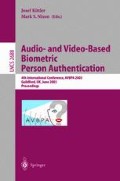Abstract
Weighted distance measure and discriminative training are two different directions to enhance VQ-based solutions for speaker identification. In the first direction, the partition normalized distance measure successfully used normalized feature components to account for varying importance of the LPC coefficients. In the second direction, the group vector quantization speeded up discriminative training by randomly selecting a group of vectors as a training unit in each learning step. This paper introduces an alternative, called heuristic weighted distance, to linearly lift up higher order MFCC feature vector components. Then two new algorithms are proposed to combine the heuristic weighted distance and the partition normalized distance measure with the group vector quantization to take full advantage of both directions. Testing on the TIMIT and NTIMIT corpora showed that the proposed methods are superior to current VQ-based solutions, and are in a comparable range to the Gaussian Mixture Model using the Wavelet or MFCC features.
Access this chapter
Tax calculation will be finalised at checkout
Purchases are for personal use only
Preview
Unable to display preview. Download preview PDF.
References
Reynolds, A.D., and Rose, C.R.: “Robust Text-Independent Speaker Identification Using Gaussian Mixture Speaker Models”. IEEE Transactions on Speech and Audio Processing, 3(1): 72–83, 1995.
He, J., Liu, L., Palm, G.: “A Discriminative Training Algorithm for VQ-based Speaker Identification”, IEEE Transactions on Speech and Audio Processing, 7(3): 353–356, 1999.
Zilca, R.D., and Bistritz, Y.: “Text Independent Speaker Identification Using Lsp Codebook Speaker Models and Linear Discriminate Functions”, Proc. 6 th European Conference on Speech Communication and Technology, (2): 799–802, Budapest, Hungary, 1999.
Sarikaya, R., Pellom, B.L., and Hansen, H.L.: “Wavelet Packet Transform Features with Application to Speaker Identification”, IEEE Nordic Signal Processing Symposium, 81–84, Vigso, Denmark, 1998.
Jang, G.J., Yun, S.J., Oh, Y.H.: “Feature Vector Transforming Using Independent Component Analysis and its Application to Speaker Identification”, Proc. 6th European Conference on Speech Communication and Technology, (2): 767–770, Budapest, Hungary, 1999.
Rosca, J., Kofmehl, A.: “Cepstrum-like ICA Representations for Text Independent Speaker Recognition”, to be presented at 4th Int. Independent Component Analysis and Blind Signal Separation, Nara, Japan, April 1–4, 2003.
Kinnunen, T., Kilpeläinen, T., Fränti, P.: “Comparison of Clustering Algorithms in Speaker Identification”, Proc. IASTED Int. Conf. Signal Processing and Communications, 222–227, Marbella, Spain, 2000.
Wang, R.H., He, L.S., and Fujisaki, H.: “A Weighted Distance Measure Based on the Fine Structure of Feature Space: Application to Speaker Recognition”, ICASSP, 273–276, 1990.
Petry, A., Zanuz, A., Barone, D.A.C.: “Bhattacharyya Distance Applied to Speaker Identification”, Int. Conference on Signal Processing Applications and Technology, Dallas, Orlando, (l): 2000.
Kinnunen, T., Fränti, P.: “Speaker Discriminative Weighting Method for VQbased Speaker Identification”, Proc. 3rd Int. Conf. on Audio and Video-based Biometric Person Authentication, 150–156, Halmstad, Sweden, 2001.
Rabiner, L. and Juang, B.: Fundamentals of Speech Recognition, Prentice Hall, 1993.
Reynolds, D.A., etl.: “The Effects of Telephone Transmission Degradations on Speaker Recognition Performance”, ICASSP, 329–331, Detroit, Michigan, 1995.
Author information
Authors and Affiliations
Editor information
Editors and Affiliations
Rights and permissions
Copyright information
© 2003 Springer-Verlag Berlin Heidelberg
About this paper
Cite this paper
Fan, N., Rosca, J. (2003). Enhanced VQ-Based Algorithms for Speech Independent Speaker Identification. In: Kittler, J., Nixon, M.S. (eds) Audio- and Video-Based Biometric Person Authentication. AVBPA 2003. Lecture Notes in Computer Science, vol 2688. Springer, Berlin, Heidelberg. https://doi.org/10.1007/3-540-44887-X_56
Download citation
DOI: https://doi.org/10.1007/3-540-44887-X_56
Published:
Publisher Name: Springer, Berlin, Heidelberg
Print ISBN: 978-3-540-40302-9
Online ISBN: 978-3-540-44887-7
eBook Packages: Springer Book Archive

